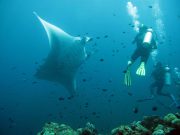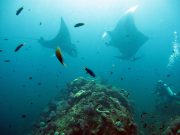Diving with Mobular Rays
Lanta Marine Life | Mobulidae
The mobular rays, the manta rays and devilfishes are a small family of rays consisting mostly of large species living in the open ocean rather than on the sea bottom. There are 11 species in this family, of which we can sometimes see 1 particular member while diving from Koh Lanta.
Mobular rays, manta rays and devilfishes are large pelagic filter feeding rays with a large wide disc and 5 gill slits on the underside. They have large pectoral fins and whip-like tails with a small dorsal fin. The pectoral fins extend forward forming 'horns' in front of the head called cephalic fins. These fins can be uncurled to scoop food into the wide mouth. The cephalic fins look like devil horns, and the rays in this family are sometimes called devil rays.
The Mobulidae currently comprises two genera, Manta and Mobula. The genus Manta encompasses two species (Reef Manta & Giant Oceanic Manta) and there are nine currently recognized species in the genus Mobula.
1 species found on this page:
Giant Oceanic Manta Ray
(Manta birostris)
Mantas are the largest of the Ray Family, reaching up to 8m from wing tip to wing tip! If we are lucky the Manta Birostris or Giant Manta, can be seen out on Hin Daeng and Hin Muang.
Rays along with Sharks are an Elasmobranch and have skeletons made up entirely of cartilage. The genus Manta is part of the Eagle Ray family, where it is grouped with Mobula Rays (Devil Rays) in the subfamily Mobulinae.

Manta birostris @ Hin Muang
There are two distinct species of Manta: the smaller Manta Alfredi, has a white or pale coloured mouth and tends to be resident in coastal areas. Manta Birostris, which is larger and has a much darker coloured mouth, these migrate across open oceans visiting reef mounts and pinnacles for cleaning, parasite removal and feeding.
Mantas have large pectoral fins, which give them a blanket-like appearance, hence their name Manta meaning "cloak" in Spanish. These large pectoral fins are able to propel them through the water, gracefully gliding and even making acrobatic movements.
Mantas are filter feeders and sieve their tiny food from the water. Most Rays have a mouth on the underside of their head, while the Manta have theirs at the front. While feeding, they use a pair of fleshy flaps on each side of its head called the Cephalic fin, to channel plankton into their mouths. These fins are rolled into spirals while not in use. Gill Rakers, finger like projections on the gill arches, strain and capture food. Like most Elasmobranch, they must keep swimming to allow oxygenated water to pass through their five pairs of gill slits.
Like Sharks, the Manta fertilises their eggs internally and gives birth to live young, called pups. The manta has one, sometimes two pups per pregnancy and are independent from birth. They will remain in shallow water for a about a year, before heading further offshore and beginning their migration cycle.
Diving with Mobular Rays around Koh Lanta
Scuba Diving & Snorkel Trips
If you'd love a chance to spot Mobular Rays on one of our daily high season diving trips from Koh Lanta then send us an email to info@diveandrelax.com.
Join our high season speedboat dive trips to some of Thailand's best dive sites and enjoy small groups, short journey times, with a focus on great personal service, safety and fun.
Not yet a certified diver? Learn to Scuba Dive on Koh Lanta with the 3 day SSI Open Water Diver course.
Book online to save 10% on dive trips and scuba courses on Koh Lanta.
Find Out More
Indo-Pacific Marine Life Guides
- Allen, G., Steene, R., Humann, P., DeLoach, N. (2003) Reef Fish Identification, Tropical Pacific. Jacksonville, FL., USA: New World Publications, Inc., ISBN 1-878348-36-1.
- Humann, P., DeLoach, N., (2010) Reef Creature Identification, Tropical Pacific. Jacksonville, FL., USA: New World Publications Inc., ISBN 978-1-878348-44-9
- Debelius, H. (2013) Indian Ocean Reef Guide. Frankfurt, Germany: IKAN - Unterwasserarchiv, ISBN 978-3-939767-52-7.
- Debelius, H. (2004) Nudibranchs and Sea Snails, Indo-Pacific Field Guide. Frankfurt, Germany: IKAN - Unterwasserarchiv, ISBN 3-925919-51-1
- Erhardt, H., Knop, D. (2015) Corals Indo-Pacific Field Guide. Frankfurt, Germany: IKAN - Unterwasserarchiv, ISBN 3-925919-69-4.
- Veron J.E.N., Stafford-Smith M.G., Turak E. and DeVantier L.M. (2016). Corals of the World


